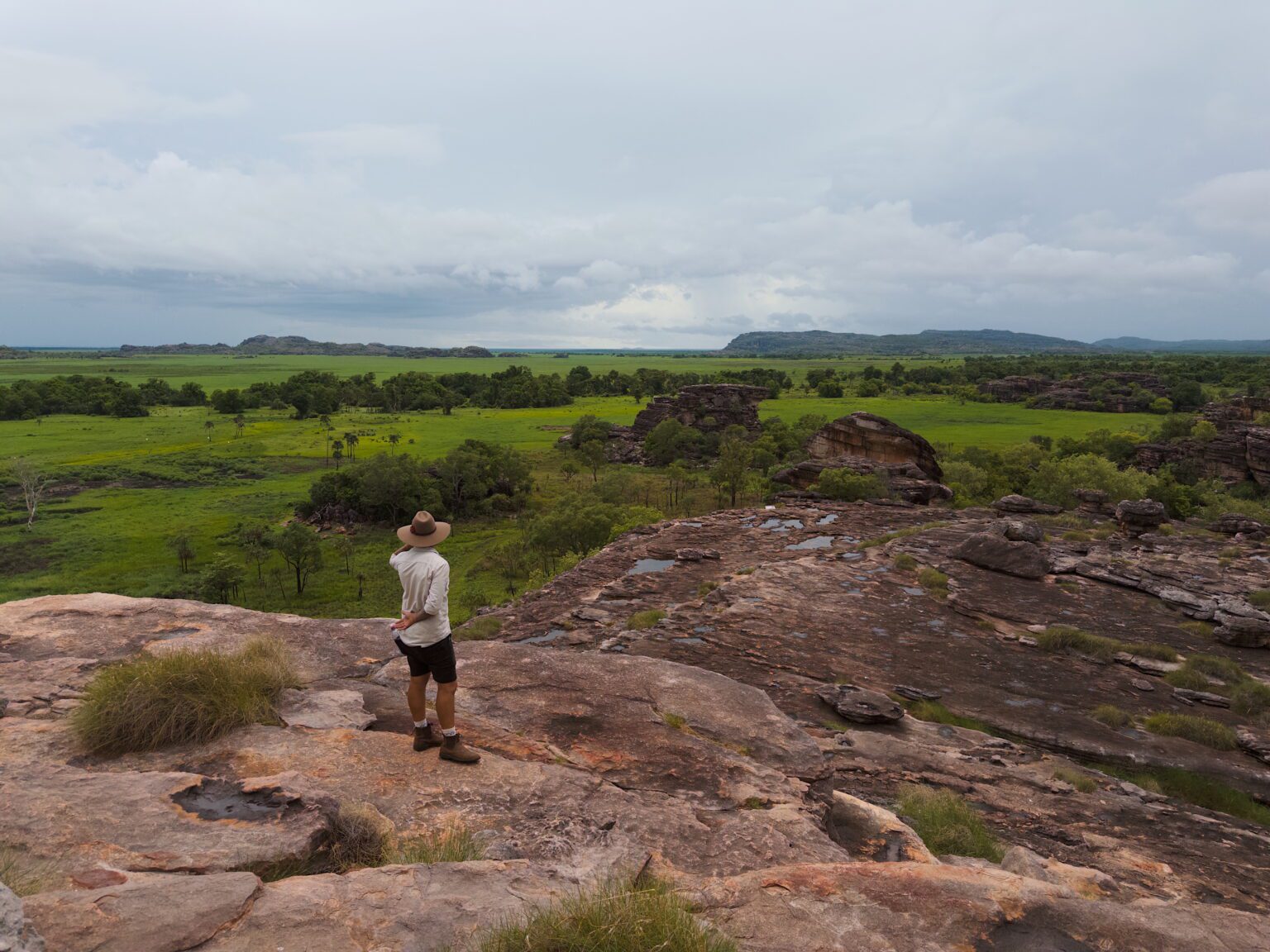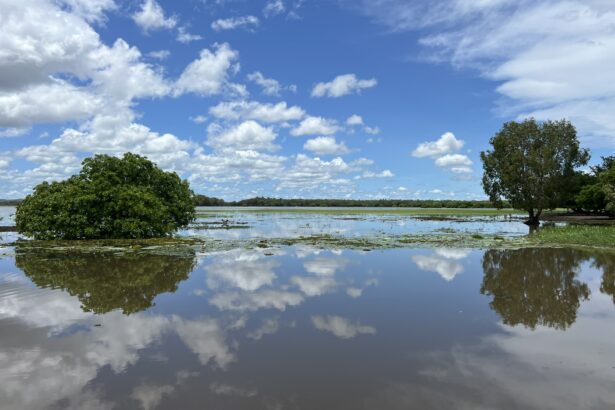Darwin and the area around, known as the Top End, is the stereotypical place that people often imagine when they think of Australia. That and the Red Desert around Uluru, which you can read about here. At least, that’s what we at Blueprint Travelers had in mind, especially since the top grossing Australian film, Crocodile Dundee, was filmed in Kakadu National Park outside of Darwin. The city is the capital city of the Northern Territory region of Australia and is a great place to anchor yourself when exploring the wildlife all around.
The Northern Territory, including the Uluru area, has the densest population of Aboriginal people in Australia. There is a wrought history regarding European colonizers and their treatment of the Aboriginal people who have occupied the Australian continent for over 50,000 years. The traditional owners and guardians of this area are the Anangu people. Traditional owners are the different Aboriginal groups that have inhabited the land for over 60,000 years. They see themselves as caretakers of the land, appreciative of what their ancestors have provided for them and maintaining the Earth for future generations. Because of this, they have a spiritual connection with the land and have many dreamtime stories (traditional narratives that explain creation of the world and animals, provide warnings for different natural phenomena, and explain the spiritual law that the communities abide by) that are tied to these important landmarks.
Options for Visiting the Darwin Region
The main reasons to visit the Darwin area is to learn more about the Aboriginal people of Australia and to explore some of the incredibly unique wildlife that makes this country so infamous. The climate here is incredibly harsh. Throughout the year, the temperature hovers between 70° F (21° C) as the low and 90° F (32° C) as the high. The seasonal differentiator is that the dry season happens between May and October and the wet season lasts between November and April.
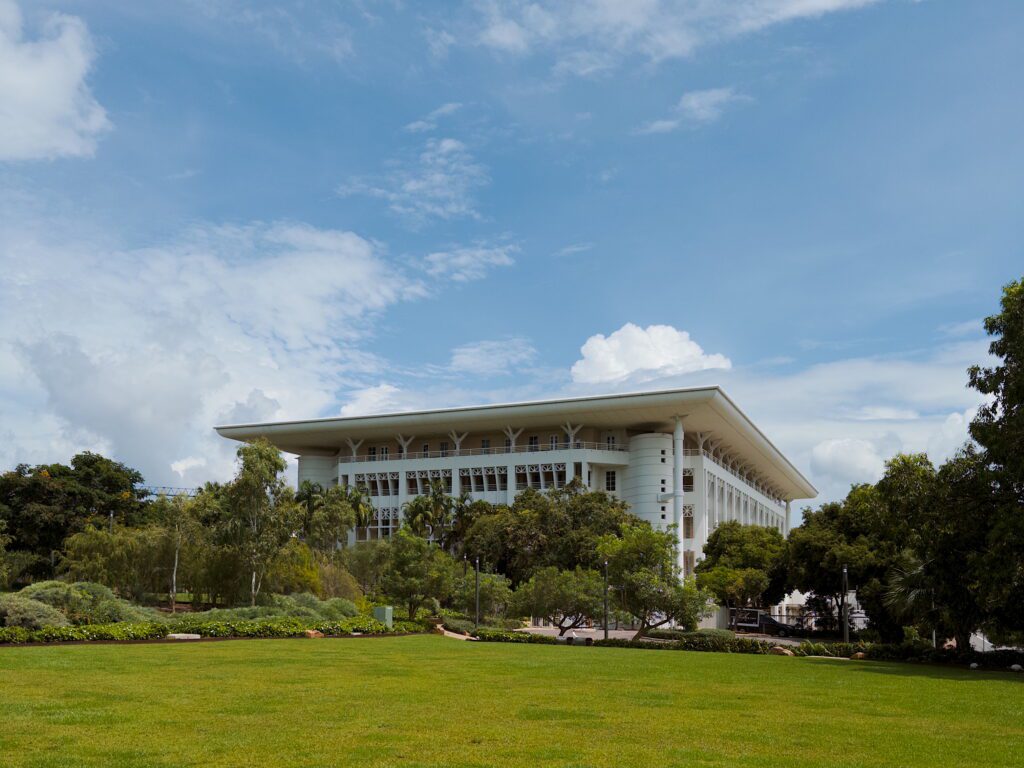
Most touring happens during the dry season for a number of reasons. First, the wet season brings torrential rain storms, some of which are even cyclones, making it challenging and unpredictable to tour throughout the region. Second, and more frighteningly, with the major increase in flooding and water levels, the large crocodiles have more mobility in the region since they prefer to reside in water, allowing them to reside in places you may have wanted to visit. Lastly, the large amount of rain could bring about flash floods, flood roadways, etc. making it challenging to navigate the region. In fact, you will see that most locals have large 4×4 cars with snorkels to allow cars to navigate the flooded roads during the wet season.
Visiting Independently
Visiting the region independently of using any tour agencies will give you the utmost flexibility with seeing and exploring different national parks. You can find different swimming holes in Litchfield National Park to spend the day picnicking and swimming. Or you can drive through Kakadu National Park exploring the artwork of the Aboriginal people and searching for unique wildlife. The best time to visit the Darwin region without a tour group or guide is in the dry season. However, a tour guide can give you necessary perspective and information to fully appreciate the significance of the area, especially in national parks that are culturally significant, such as Kakadu National Park.

We recommend renting (hiring in Australia) a 4×4 vehicle to navigate the unpaved and potentially flooded roads of the different national parks. In addition, when looking to swim in different watering holes, make sure that it has been marked free of crocodiles. The ones in the national parks are cleared prior to the opening of the park every season and monitored by the park services. Do not approach or swim in random ponds or lakes in the region! Crocodiles can stay underwater for hours, can stay in pools of water of varying sizes, and, most frighteningly, are much faster than any of your reactions.
Using Group Tours
Group tours are an efficient and easy way to explore the variety of national parks around Darwin. They allow you to avoid hiring a vehicle and eliminate the need for you to do additional research and develop your own itinerary. These tours often pick you up from and drop you off at your accommodations in Darwin. And with many of these parks located a few hours away from the city, having a driver makes the entire day enjoyable and relaxing.
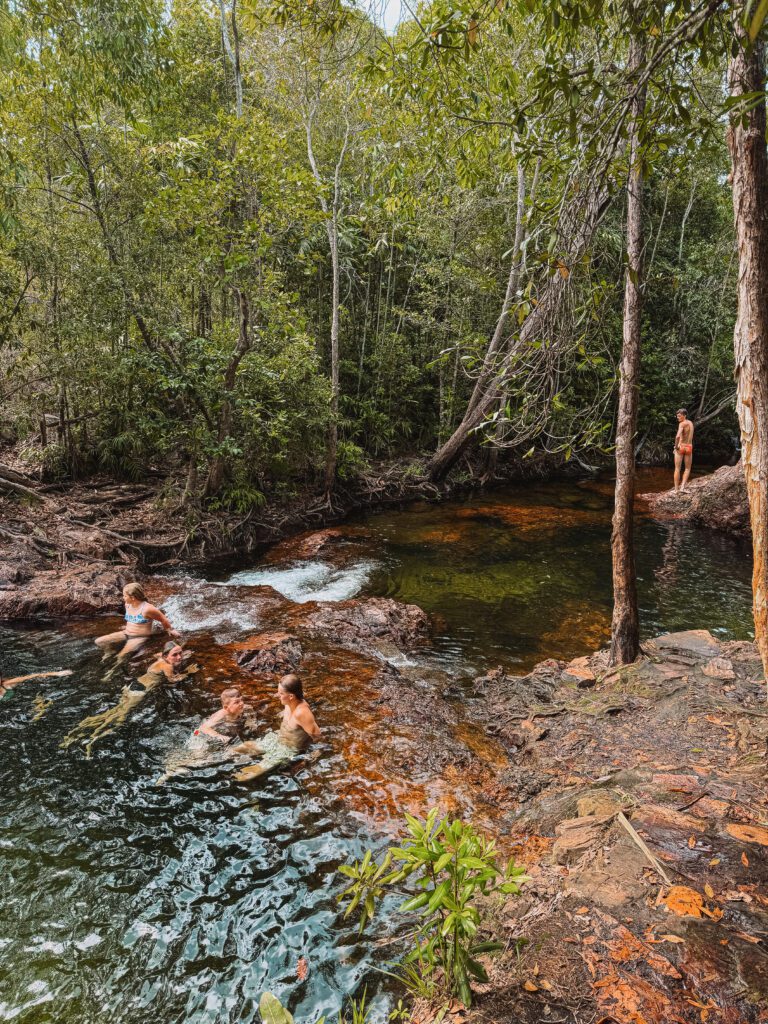
There are numerous group tours that run between the city and the different national parks around Darwin. We recommend looking into Offroad Dreaming or Kapalga Travel if you want to use a local group tour operator. If you are looking for a larger organization for your tour group, consider Autopia Tours, an Australian tour company focused on smaller group ecotourism opportunities.
You may also want to consider a multi-day tour with any of the companies listed above to visit different and varied parts of the region. These tours may include the different parks listed below and provide an authentic camping experience throughout the region (or hotel lodging if that is preferred).
Organization Highlight
Private tours allow you to have a tour that is fully designed to your own interests with an incredibly knowledgeable guide in a personalized and bespoke experience. It allows you to dive deeper into the wildlife and cultural interests you may have regarding the region.
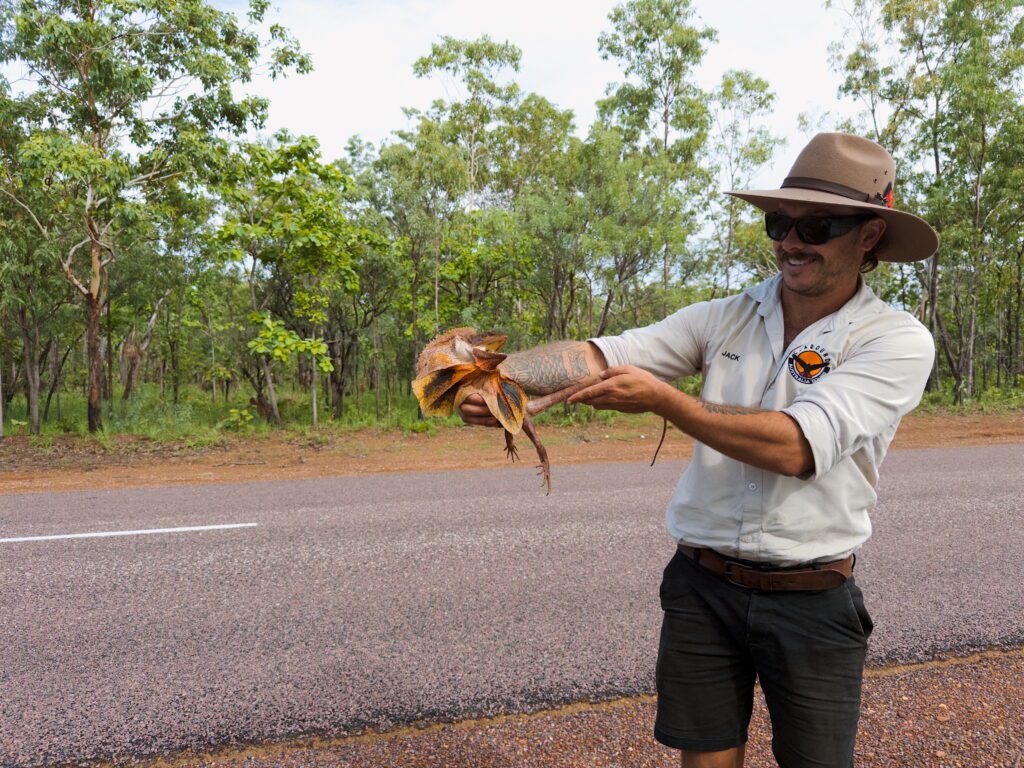
There are a few different companies that provide these services but none more comprehensive than Cyaround Australia Tours. Jack and Storm are the co-owners of the company and while Jack is the main tour guide, Storm coordinates the trips, helps design the itineraries, and makes some of the meals. This luxury experience is the ultimate way to vacation in this region because it makes the Australian thrill, adventure, and culture that the region is so known for a comfortable experience. Check out their example itineraries on their website and reach out to them to design your ultimate Top End adventure.
With Cyaround Australia Tours, you can plan for a one-day outing or a multi-day excursion. For any option, they coordinate delicious meals, comfortable accommodations, and valuable experiences that will make your time in the Darwin region incredibly memorable.
Kakadu National Park
Kakadu National Park is an enormous natural reserve within the Top End of Australia, located about 3 hours away from Darwin. The park is famous for its incredible landscapes, wildlife, including the impressive saltwater crocodiles, and beautiful rock paintings by the local Aboriginal people.
There are a number of different Aboriginal peoples who are the Traditional Owners of the national park. About half of the land has been returned to the Traditional Owners and the park is managed by both the Aboriginal people and the national park services, making sure that decisions are made that align with both the Aboriginal people who have inhabited the land for over 50,000 years and the goals of the park services. This has not always been the case and the Aboriginal people now protect their land from cultural exploitation, making only some of the spiritual sites and rock art locations available to the public.
The main reasons for visiting Kakadu National Park are to see some of the locations of saltwater crocodiles, swim under some waterfalls during the dry season only, and visit some of the rock art. To get more information about the park and the culture of the region, you should visit the Bowali Visitor Centre, which includes a museum with a lot of information regarding the people and animals of the Top End.
Saltwater Crocodiles in Kakadu National Park
The national park has a few rivers that are full of saltwater crocodiles, one of the apex predators of the world. These animals can be up to 7 meters (23 feet) long and are incredibly stealthy. You will not be able to defend yourself if attacked by one of these animals, so staying safe is incredibly important. Stay a few meters away from the banks of rivers and ponds to avoid being snatched and follow the instructions and warnings of all signs throughout the park.
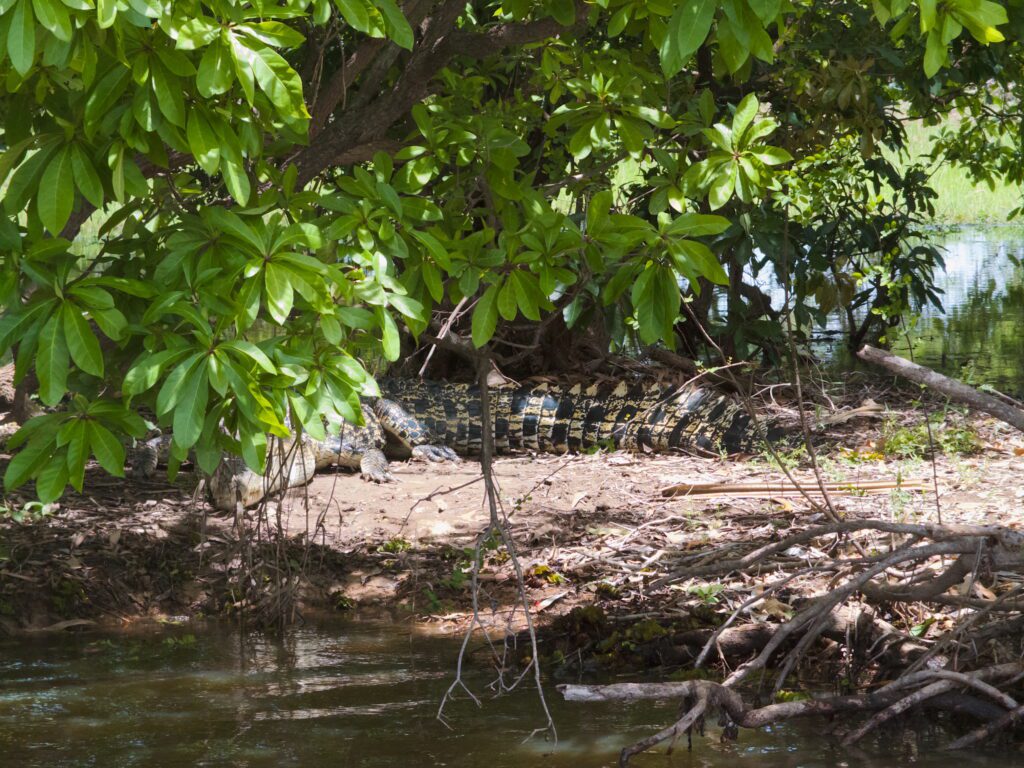
Cahills Crossing
Cahills Crossing is an infamous road that runs over a river that is full of saltwater crocodiles. It is one of the most popular destinations to see the animals due to the feeding frenzy that happens here. During the dry season, the tides can change the flow and height of the river, pushing water full of fresh fish over the road and directly into the mouths of the crocodiles that are on the other side. The best time to see this phenomenon is between July and October from the provided viewing platforms that keep you a safe distance from the water and the jaws of these creatures. It is vitally important to remain on these platforms to watch the crocodiles, follow all the signs throughout the area, and not cross the road while flooded for your own safety.
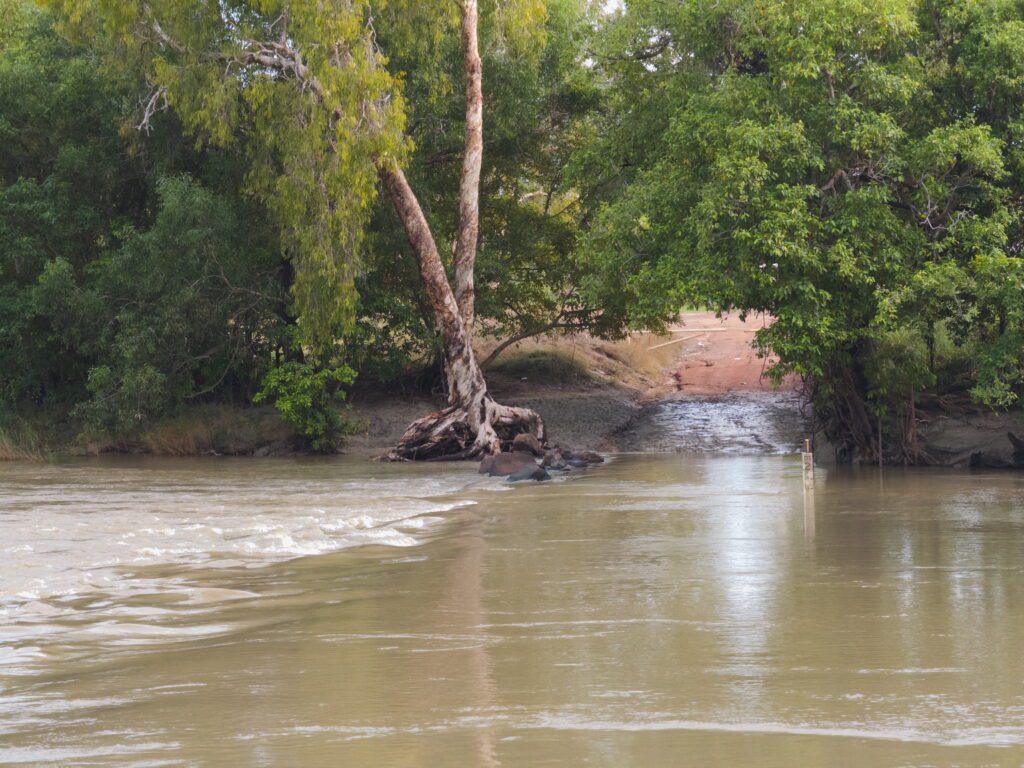
Yellow Water and Yellow Water Cruises
Yellow Water wetlands, also known as Ngurrungurrudjba by local Aboriginal people, is another destination where you can safely see the crocodiles that live in the South Alligator River system. The Yellow Water cruises are owned by Indigenous people and provide 90 or 120-minute long cruises that give information about the crocodiles and birds that make the region so unique. The excursions occur year-round and flora and fauna can vary based on the season.
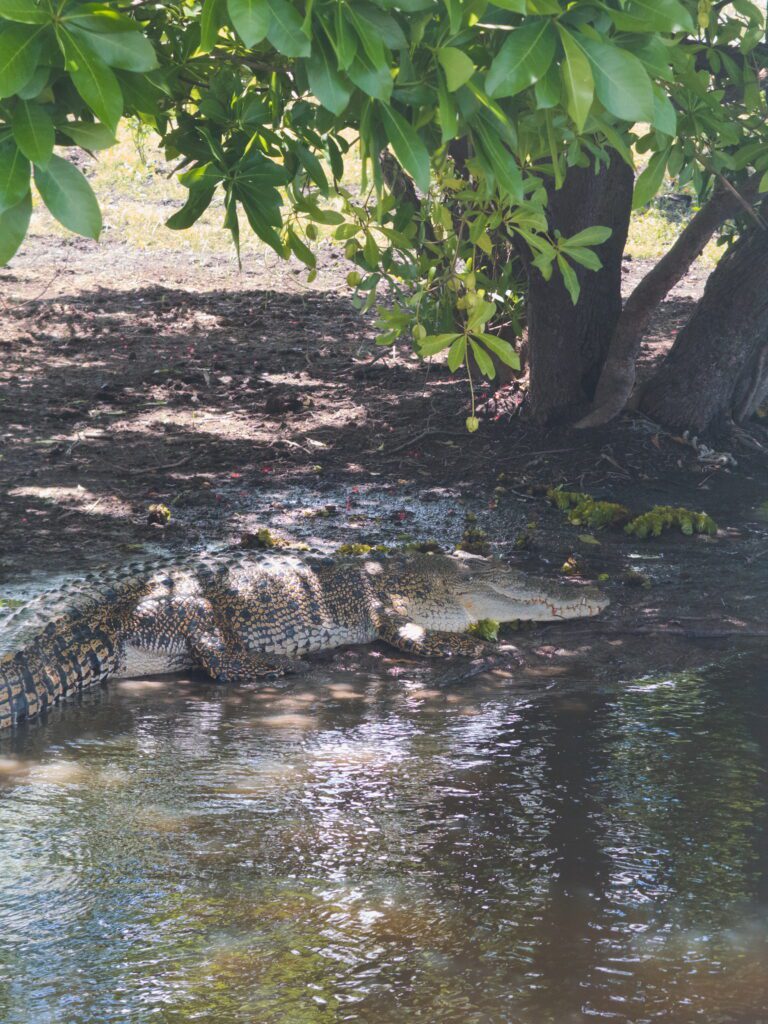
Swimming Waterholes and Waterfalls
During the dry season, there are a few waterholes with incredible waterfalls that can be visited. Unfortunately, during the wet season, the roads to get to these different destinations can be flooded and crocodiles have more ability to move to different parts of the park through this flooding. Some of the most visited waterholes within the park include Twin Falls, Jim Jim Falls, Maguk (Barramundi) Gorge, Gunlom Falls, among others. Talk to the Bowali Visitor Centre to find out which destinations are open for people to swim in (have been cleared of crocodiles).
Aboriginal Rock Art
The Aboriginal rock art of Kakadu National Park is some of the most prolific that a visitor can see when in Australia. The best place to see it is at Ubirr. This area is a collection of large rocks covered in art that depicts stories, ancestors, spirits, and animals. The Aboriginal people used drawings of animals in an x-ray depiction to show the best parts of the animal to eat and how to kill the animal, using the walls of the rock and paint to document biological knowledge.
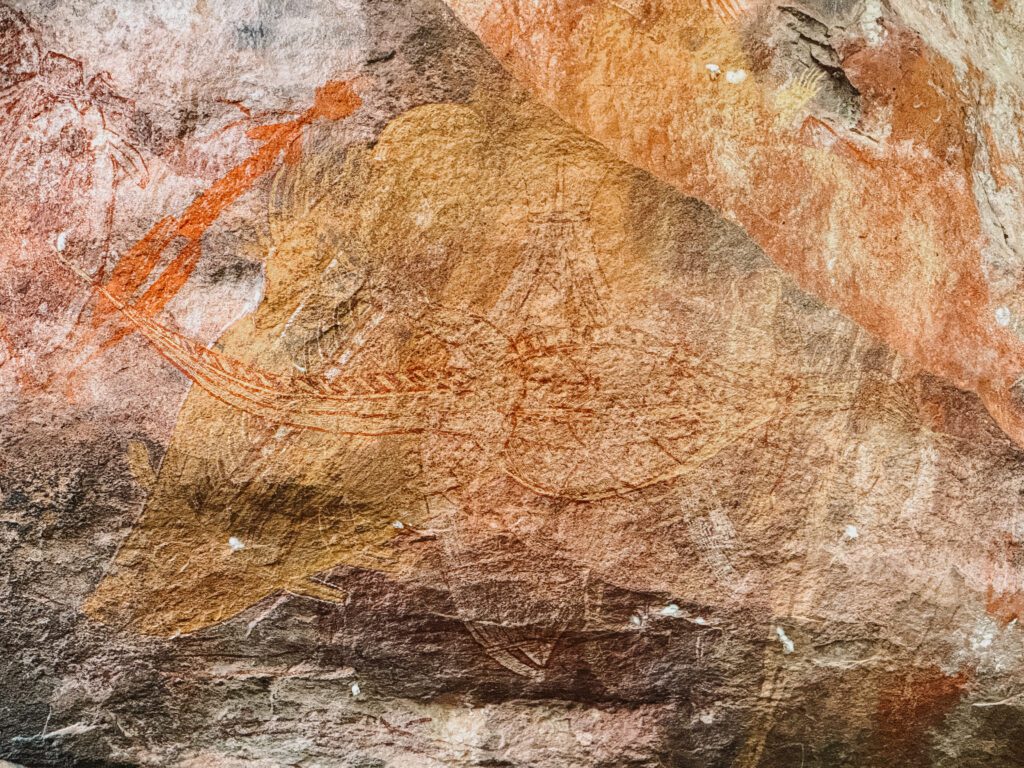
Another important site for rock art within the park is Burrunggui (Nourlangie) Rock. The rock itself has immense cultural significance to the Aboriginal people of the region and has a few paintings that can be visited to see depictions of stories and spirits for the local groups.
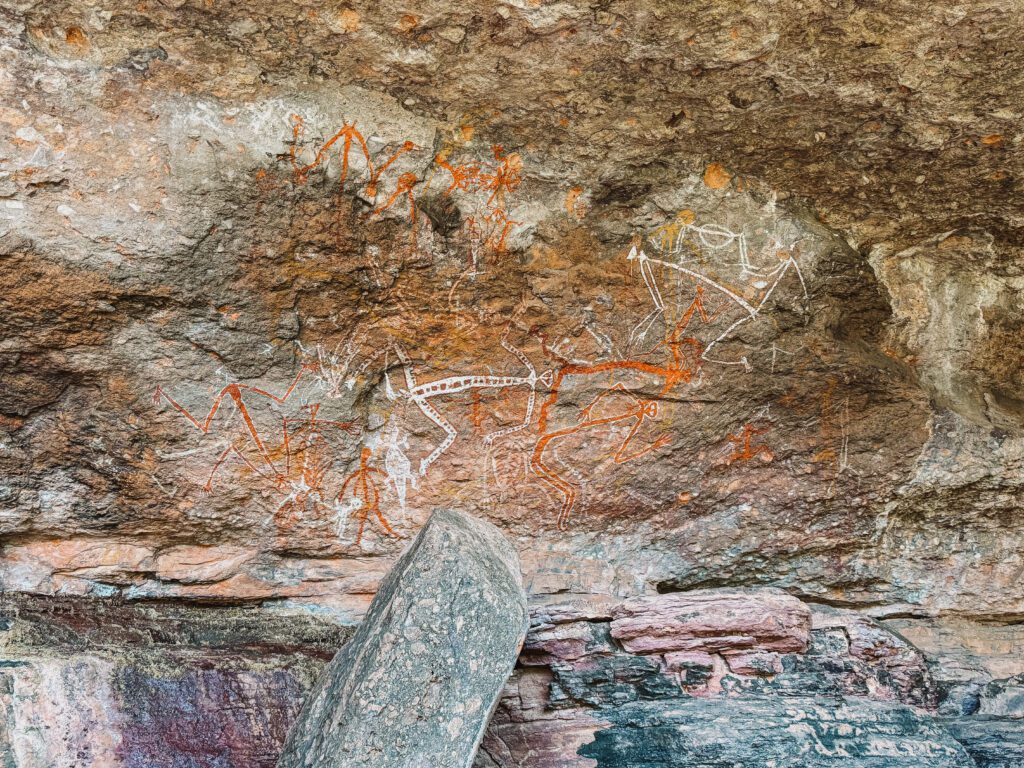
We recommend visiting the park with a guide because they can give you much more information about the history of the artwork and the importance of the different locations.
Litchfield National Park
Litchfield National Park is a protected nature reserve that is easier to access than Kakadu National Park, being less than 2 hours from Darwin. Because of this, it is more accessible to people to visit for a day trip, either independently or as part of a tour group.
Swimming Waterholes and Waterfalls
During the dry season, there are a few waterholes with incredible waterfalls that can be visited. Unfortunately, during the wet season, the roads to get to these different destinations can be flooded and crocodiles have more ability to move to different parts of the park through this flooding. Some of the most visited waterholes within the park include Twin Falls, Jim Jim Falls, Maguk (Barramundi) Gorge, Gunlom Falls, among others. Talk to the Bowali Visitor Centre to find out which destinations are open for people to swim in (have been cleared of crocodiles).
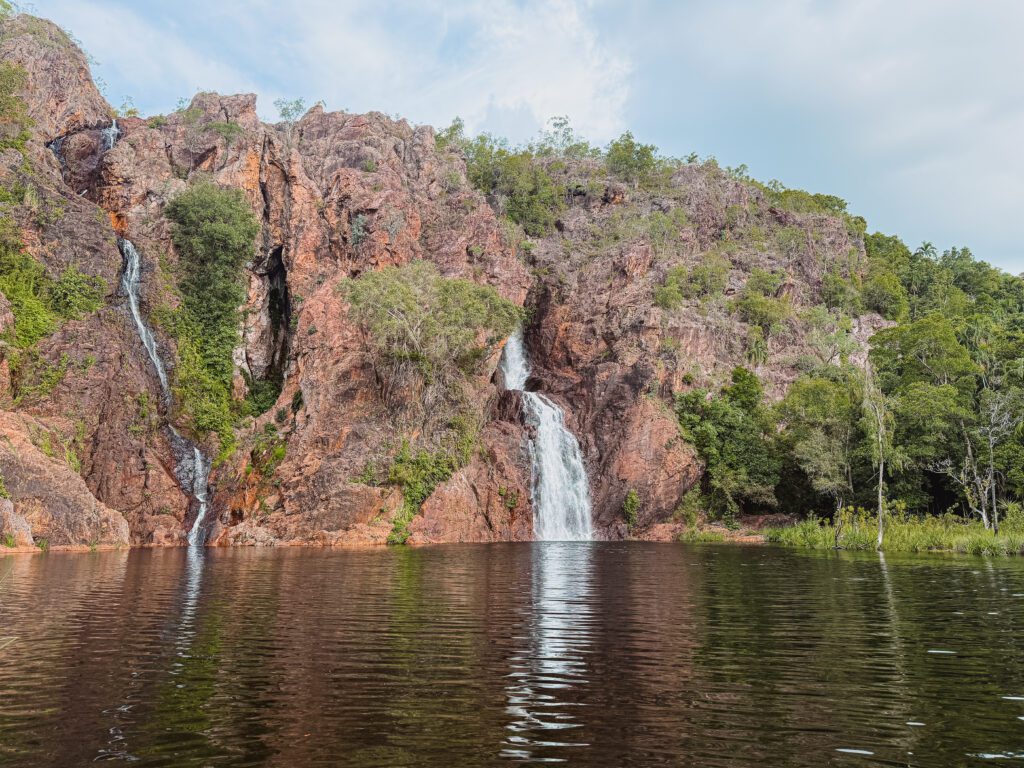
Termite Mounds
The termite mounds of Litchfield National Park are incredible and quite significant. As you drive through the park, you will see them towering along the side of the road. There are two kinds of termites and their mounds in the national park. The first are the Cathedral Termite Mounds that make enormous mounds that can reach upwards of 15 feet (4.5 meters) in height.

The second of the termite mounds are the Magnetic Termite Mounds, which cover large fields in a tomb-like fashion. The mounds are incredibly narrow with the large, flat face of the mound facing north-south to help maintain the temperature of the mound. As a result, all of the mounds line up facing the same direction in these fields. For both of these phenomena, there are viewing areas and platforms within the park where you can get the best views.

Where to Stay in Darwin
Waterfront Precinct
The waterfront precinct of Darwin is a modern and new area of the city that has restaurants, bars, a protected beach and pool area, a wave park, a hotel, and more. (Admittedly, it feels very manufactured.) If you are looking for a modern, easy, and quiet area, consider staying in the waterfront precinct. While it is isolated, it is easy to access the central business district via the elevator and walkway that goes directly there.
Central Business District (CBD)
The Central Business District of Darwin is where most of the commercial center of the city is located. Here, you will find local restaurants, cafes, shops, tourist offices, galleries, etc. This is the city center of a capital city, so there may be some more character and riffraff in this part of town. That being said, if you are aware of your surroundings and avoid putting yourself in vulnerable situations (walking down dark and empty streets), you will still be able to enjoy the conveniences of being in this part of town. And when in doubt, consider taking a taxi or Uber to get around town.
Other National Parks
There are a few other national parks in the Top End that are worth visiting to see more extraordinary nature and learn more about the Aboriginal people and culture that has inhabited this land for over 50,000 years. Because of the distance between all the national parks in the region, we recommend finding tour groups to visit the different areas or even exploring a multi-day tour option to get the most out of the Darwin area.
Nitmiluk (Katherine Gorge) National Park
The Katherine Gorge National Park is located 3 hours south of Darwin, making it quite a distance to travel, which is why we recommend using a tour group to explore this national park. You can take a boat cruise through the gorge, learn more about the Jawoyn people (the Aboriginal people of the area), and swim in Edith Falls or other swimming pools (depending on the season).
Tiwi Islands
The Tiwi Islands are located a ferry ride away from Darwin and are the home of the Tiwi people. A tour to these islands is a cultural experience, diving deeper into the religion, way-of-life, history, and culture of this Aboriginal group. Often, tours are led by a local Tiwi guide, giving a more fulfilling and local perspective on this modern Aboriginal community. You will need to have a tour to visit the island and get a lot of value out of the experience. The ferries and tours to the island only run during the dry season.
Seeing Saltwater Crocodiles
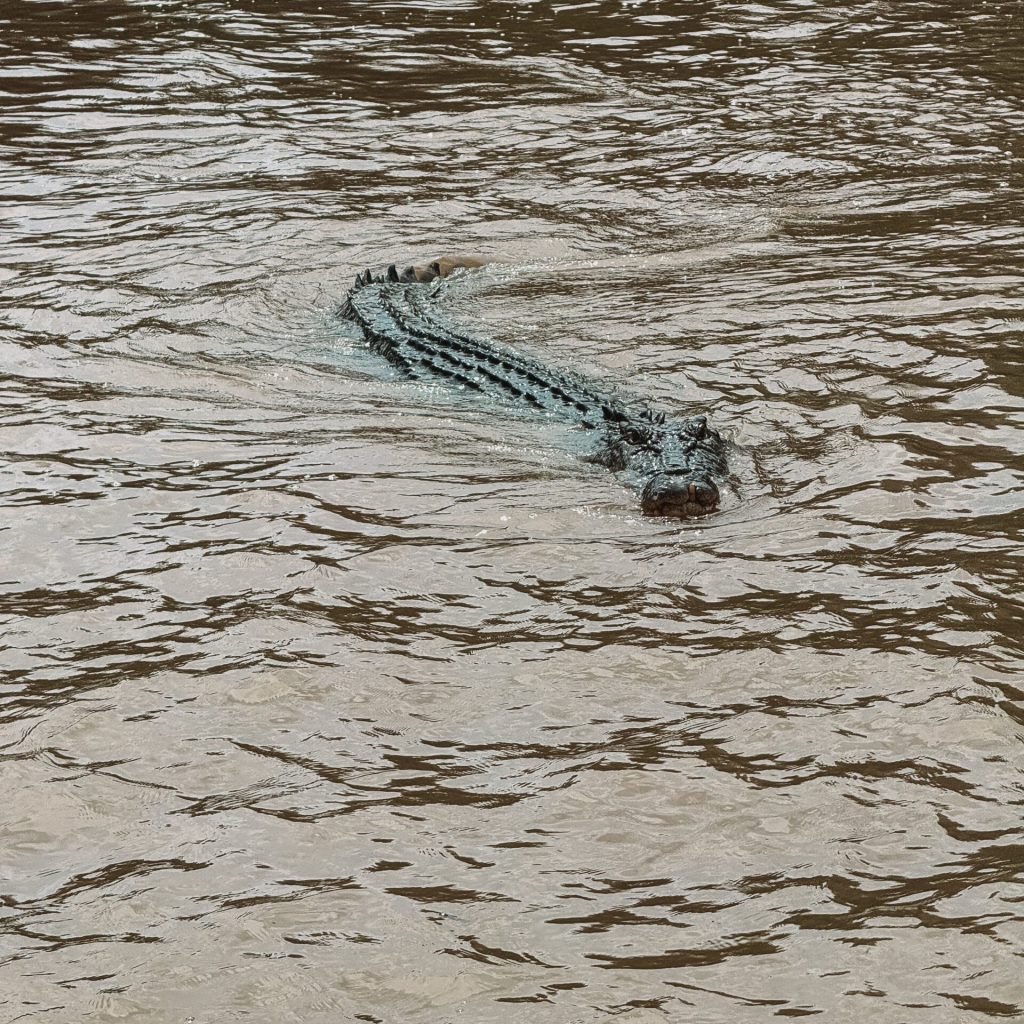
One of the main attractions to the Darwin region is the ability to see saltwater crocodiles in the wild and much of the tourism in the region is built off of this attraction. You will find that most tours to the different national parks include a stop at a crocodile cruise. While some cruises only navigate rivers and point out these impressive creatures, others bait the crocodiles with pieces of meat to show you their impressive capabilities.
There are always questions over the morality of this practice so attending one of these tours is truly up to you. Getting the opportunity to see a crocodile lunge out of the water is frighteningly thrilling. However, does this make these crocodiles dependent on humans to feed them? The tour operators claim that this is not the case. They claim that, as apex predators, these crocodiles are capable of finding their own source of food and the food that they supply would not be sufficient for them to survive. Even with the food provided by these tours, the animals continue to show their natural instincts by maintaining their territories, guarding their female crocodiles from other males, and even going so far as to eat crocodiles that they consider threats. Should we be making them jump out of the water with the dangle of food for our enjoyment? The answer to that question is really up to you.
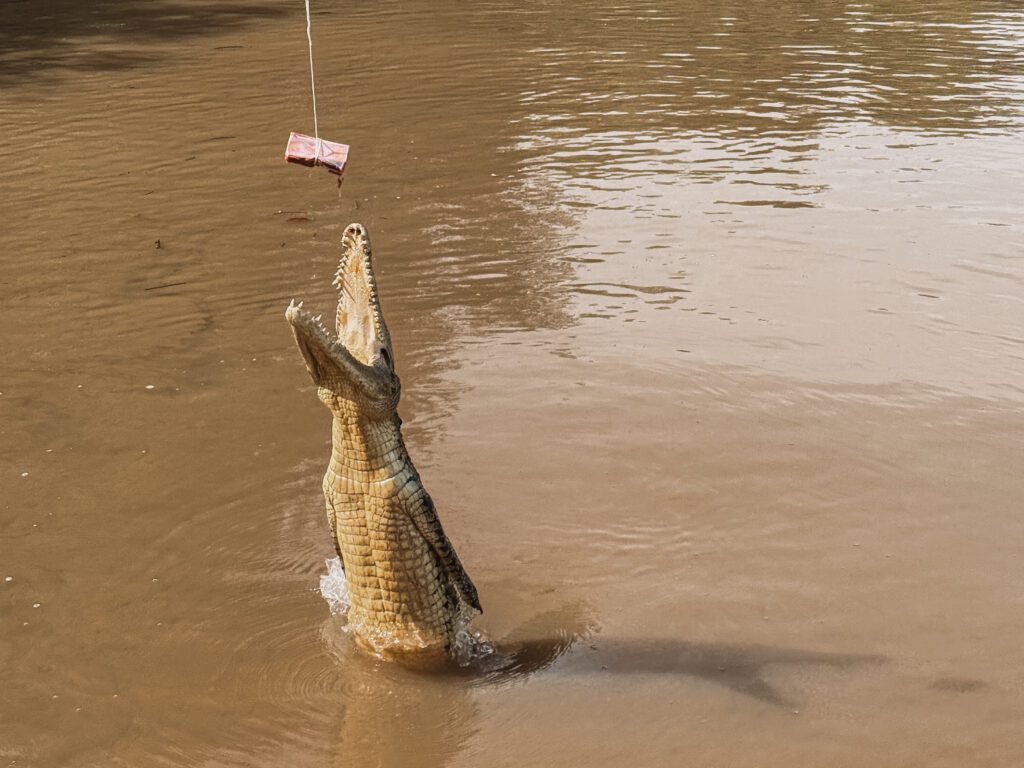
Things to Do in Darwin
If you are visiting the Darwin area, it may be worth spending a day exploring the city itself to learn about the city’s role as a capital city of a territory, the importance of WWII in the region, and absorb the multi-cultural aspects of the region
Darwin Waterfront Precinct
Darwin’s waterfront precinct is a newer part of town and was constructed to take advantage of its coastal location. The neighborhood is full of restaurants and bars and includes a protected beach area (no crocodiles!) and a wave park, both of which are incredibly family friendly. This is a nice area to relax and refresh yourself in the Darwin heat.
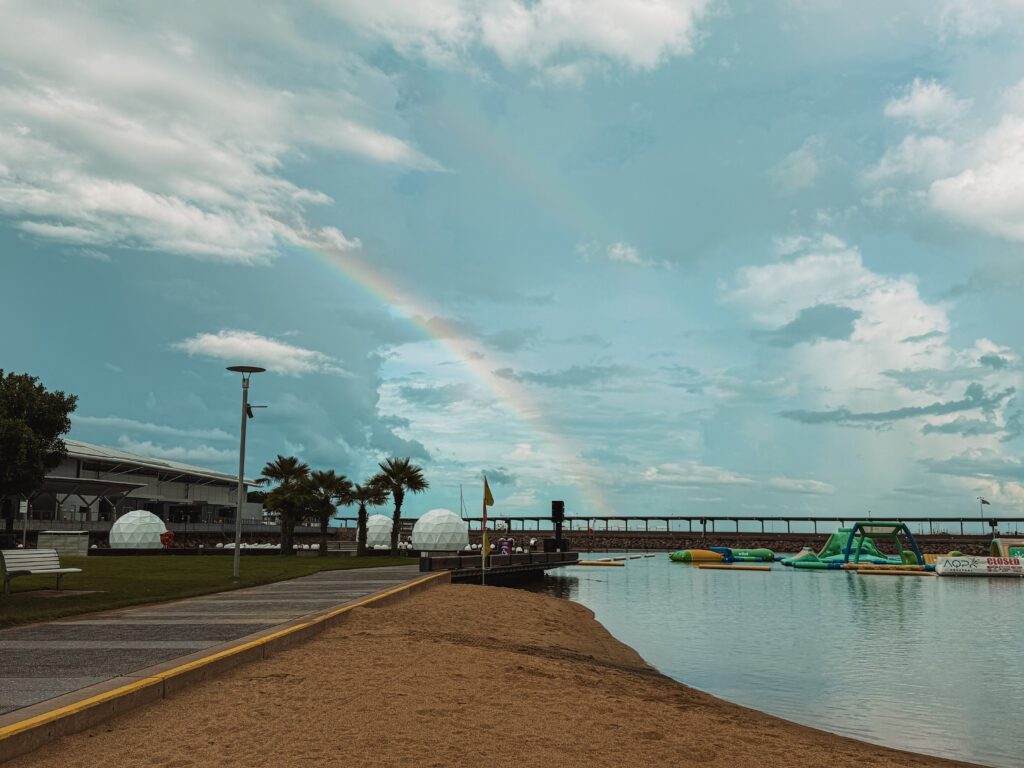
Darwin’s Role in WWII
Darwin, being the northernmost port city of Australia, was impacted by the naval battles of World War II in the Pacific Ocean. The Darwin port and some other parts of the city were attacked by Japanese war planes, the same ones that attacked Pearl Harbor. You can learn more about the role of the country and this particular location in the war at a few different museums in Darwin. In addition, you can find some evidence of the war in the city today, including the tunnels and bunkers adjacent to the waterfront precinct.
Darwin Military Museum
The Darwin Military Museum is located at East Point along with the Defence of Darwin Experience. The museum has a number of artifacts from the war and explains Australia’s involvement in conflicts where troops were deployed over the last few centuries.
RFDS Darwin Tourist Facility

The RFDS Darwin Tourist Facility is located at the pier of the waterfront precinct. This facility specifically discusses the role of Darwin in World War II through different mediums. They have virtual reality simulations of the attacks, short films of different stories of those who were in the war, and panels of information about the war itself. The museum, while small, is dense with information that focuses on the Northern Territory and Top End region. The second part of the museum has to do with the Royal Flying Doctor Services, an aeromedical service that supports the vast and vacant areas of the Northern Territory and Western Australia. Their work includes bringing physical, mental, and oral health clinics directly to rural communities and providing emergency medical services that fly directly to clients for life-saving services. You can learn more about their work, especially within the unique circumstances of the large Australian continent, at this museum.
Austin Lane and West Lane: Darwin’s Street Art
Darwin’s central business district is full of beautiful street art that celebrates the culture of the Top End, the nature in this area, and the Aboriginal people who have inhabited this land for so long. The local government has developed an app that can give you information about the artwork that you are looking at throughout the city. You can learn more about the app here. Much of the art is concentrated on Austin Lane and West Lane within the city center so wander through these two lanes to see the beautiful artwork.
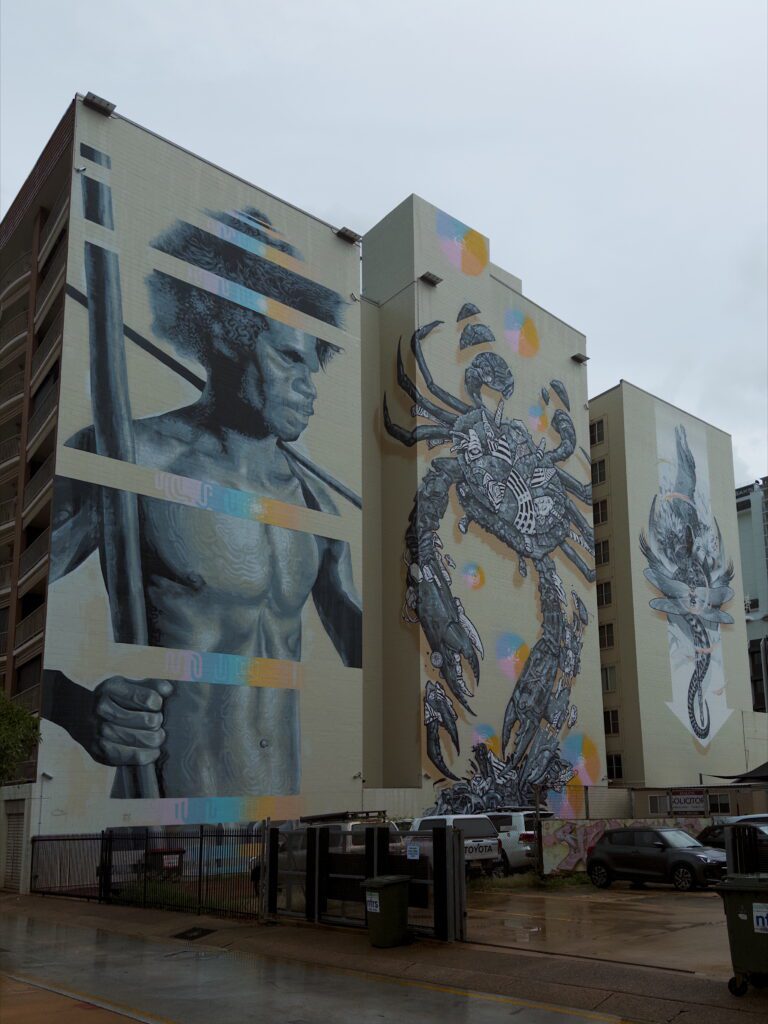
Museum and Art Gallery of the Northern Territory
The Museum and Art Gallery of the Northern Territory holds a concentration of local art in the region. If you are interested in seeing original and modern Aboriginal artwork along with explanations of what you are seeing, then consider visiting this free museum. In addition, the museum has some permanent exhibitions about the animals, plants, and people of the region. And there are rotating exhibits that explain local history, such as the 50th anniversary of Cyclone Tracy that ripped through the Top End and caused major destruction on Christmas Eve 50 years prior.
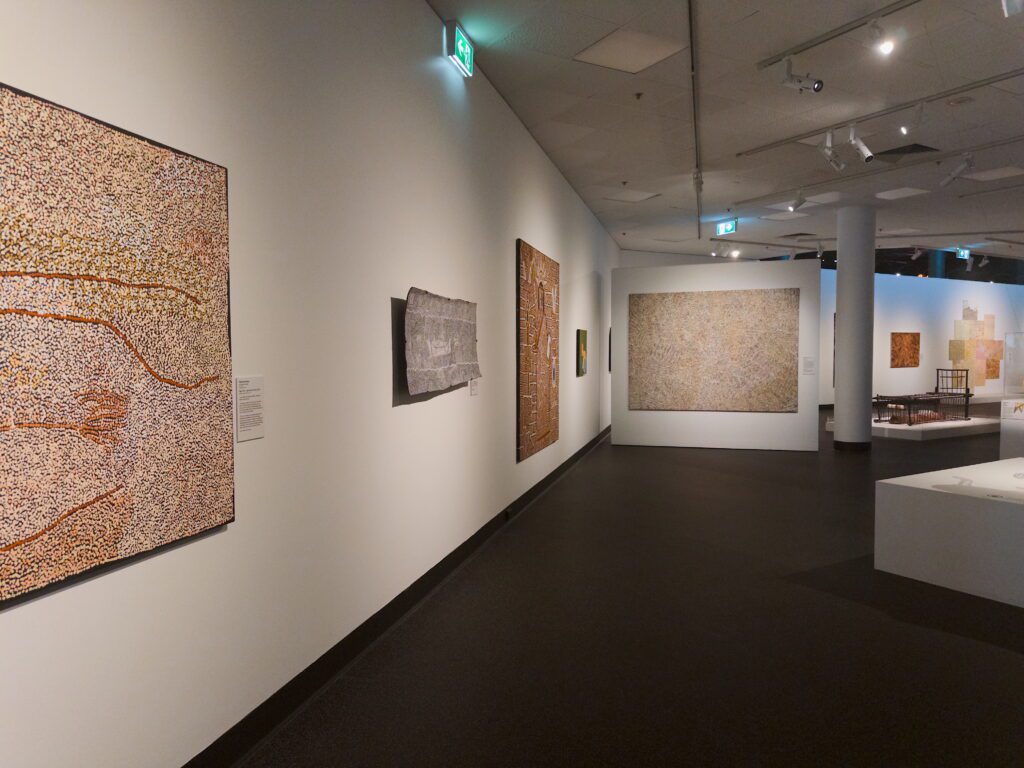
Parap Market
Every Saturday between 8 AM and 2 PM, the Parap neighborhood of Darwin hosts a market. At this market, you can find artisanal goods and delicious laksa. Laksa is a rich coconut curry soup that originates in Malaysia. Due to the city’s proximity to Asia, there is a large influence and immigration population here, and as a result, laksa is one of the most highly acclaimed dishes in the city.
Mindil Beach
During the dry season, Mindil beach hosts an evening market on Thursdays and Sundays where you can find a wide variety of stalls that celebrate the diverse culture of the Darwin area. In addition, you can experience one of the beautiful sunsets that make this part of Darwin so popular to watch the sun go down.
A Sample 4-Day Itinerary to Visiting Darwin and the Top End
The following itinerary is intended to be a starting point for visiting Darwin. It allows you to see the highlights of the region through a variety of group tours or independent travel. You should tailor the itinerary to your own interests.
DAY 1
Explore Darwin by visiting the RFDS Darwin Tourist Facility, the central business district to see Darwin’s street art, the Museum and Art Gallery of the Northern Territory, and Mindil beach.
DAY 2
Take a day tour of Litchfield National Park
DAY 3
Take a day tour of Kakadu National Park
DAY 4
Take a day tour of the Katherine Gorge (Nitmiluk) National Park
Read More About the Blueprint Travelers' Personal Experience in Darwin
Update 50: Exploring Australia’s Tropical Top End from Darwin, the Northern Territory’s Capital
We visited Australia’s furthest north capital city Darwin to explore the incredible Kakadu and Litchfield National Parks within the Top End.

